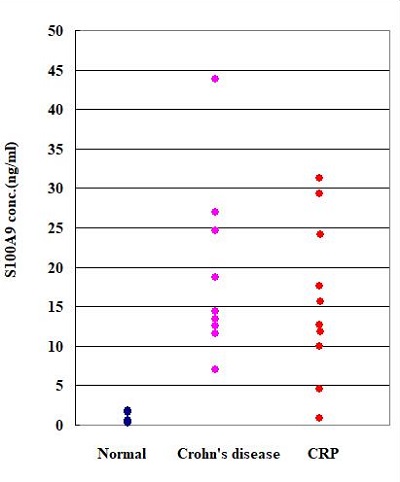CircuLex S100A9/MRP14 ELISA Kit
Product Code:
MBL-CY-8062
MBL-CY-8062
Regulatory Status:
RUO
RUO
Application:
Enzyme-Linked Immunosorbent Assay (ELISA)
Enzyme-Linked Immunosorbent Assay (ELISA)
Shipping:
4°C
4°C
Storage:
4°C
4°C
No additional charges, what you see is what you pay! *
| Code | Size | Price |
|---|
| MBL-CY-8062 | 96 Assays | £602.00 |
Quantity:
Prices exclude any Taxes / VAT
Stay in control of your spending. These prices have no additional charges, not even shipping!
* Rare exceptions are clearly labelled (only 0.14% of items!).
* Rare exceptions are clearly labelled (only 0.14% of items!).
Multibuy discounts available! Contact us to find what you can save.
This product comes from: United States.
Typical lead time: 10-14 working days.
Contact us for more accurate information.
Typical lead time: 10-14 working days.
Contact us for more accurate information.
- Further Information
- Documents
- References
- Show All
Further Information
Background:
The S100A9/MRP14 protein and S100A8/MRP8 belong to the low molecular mass calcium-binding S100 proteins (1), they are composed of two distinct helix-loop-helix motifs (EF-hands) flanked by hydrophobic regions at either terminus and separated by a central hinge region. In human, S100A9/MRP14 is usually co-expressed with S100A8/MRP8. Both proteins are expressed during myeloid differentiation, are abundant in granulocytes and monocytes, and form heterodimeric complexes (2). Although a number of possible functions for S100A8-A9 heterocomplex, including antimicrobial activity, have been proposed, the exact role of these proteins in cell metabolism is still unclear. In human, they have been associated with several inflammatory diseases (3): phagocytes expressing S100A9 belong to the early infiltrating cells and dominate acute inflammatory lesions; in addition, elevated serum levels of S100A8 and S100A9 have been found in patients suffering from a number of inflammatory disorders including cell arteritis (4), cystic fibrosis, rheumatoid arthritis, dermatoses, chronic inflammatory bowel disease, chronic bronchitis (3), some malignancies and autoimmune diseases (5, 6). Both proteins are localized predominantly in the cytoplasm. An increase in the intracellular calcium concentration leads to a translocation of S100A9 from the cytoplasm to the plasma membrane (7). In addition, it could be demonstrated with human monocytes that both proteins are secreted by an energy-consuming pathway, which is dependent on an intact microtubule network and involves protein kinase C (8). It was reported that S100A9 is a the molecular target of quinoline-3-carboxamides, which are currently in Phase II and III development for treatment of autoimmune/inflammatory diseases in humans (9).
Description:
The CircuLex Research Product S100A9/MRP14 ELISA kit is used for the quantitative measurement of human S100A9/MRP14 in serum, plasma and other biological media.
Gene IDs:
Human: 6280 Mouse: 20202
Kit Components:
Microplate, 10xWash Buffer, Sample Dilution Buffer, Standard Dilution Buffer, Human S100A9 Standard, HRP conjugated Detection Antibody, Substrate Reagent, Stop Solution
Measurement Range:
Dilution factors need to be taken into consideration in calculating the human S100A9/MRP14 concentration. Results exceeding human S100A9/MRP14 level of 16 ng/ml should be repeated with diluted samples.
Sensitivity:
better than 6.55 pg/ml of sample.
Target:
S100A9/MRP14
Documents
References
1. Odink, K. et al. (1987) Nature 330, 80-82.
2. Kerkhoff, C., Klempt, M. & Sorg, C. (1998) Biochim. Biophys. Acta 1448, 200-211.
3. Sorg, C. (1992) Behring Inst. Mitt. 91, 126-137.
4. andez-Rodriguez, J., Sanchez, M., Vogl, T., Cid, M. C., and Roth, J. (2004) J. Pathol.
204, 311?316
5. Nacken, W., Roth, J., Sorg, C., and Kerkhoff, C. (2003) Microsc. Res. Tech. 60, 569?580
6. Foell, D., Frosch, M., Sorg, C., and Roth, J. (2004) Clin. Chim. Acta. 344, 37?51
7. Van den Bos, C., Roth, J., Koch, H.G., Hartmann, M. & Sorg, C. (1996) J. Immunol. 156, 1247?1254.
8. Roth, J., Goebeler, M., Klempt, M., Hartmann, M. & Sorg, C. (1997) J. Biol. Chem. 272,
9496?9502.
9. Bjork, P. et al. (1997) PLoS Biol. 7, e1000097, 2009




